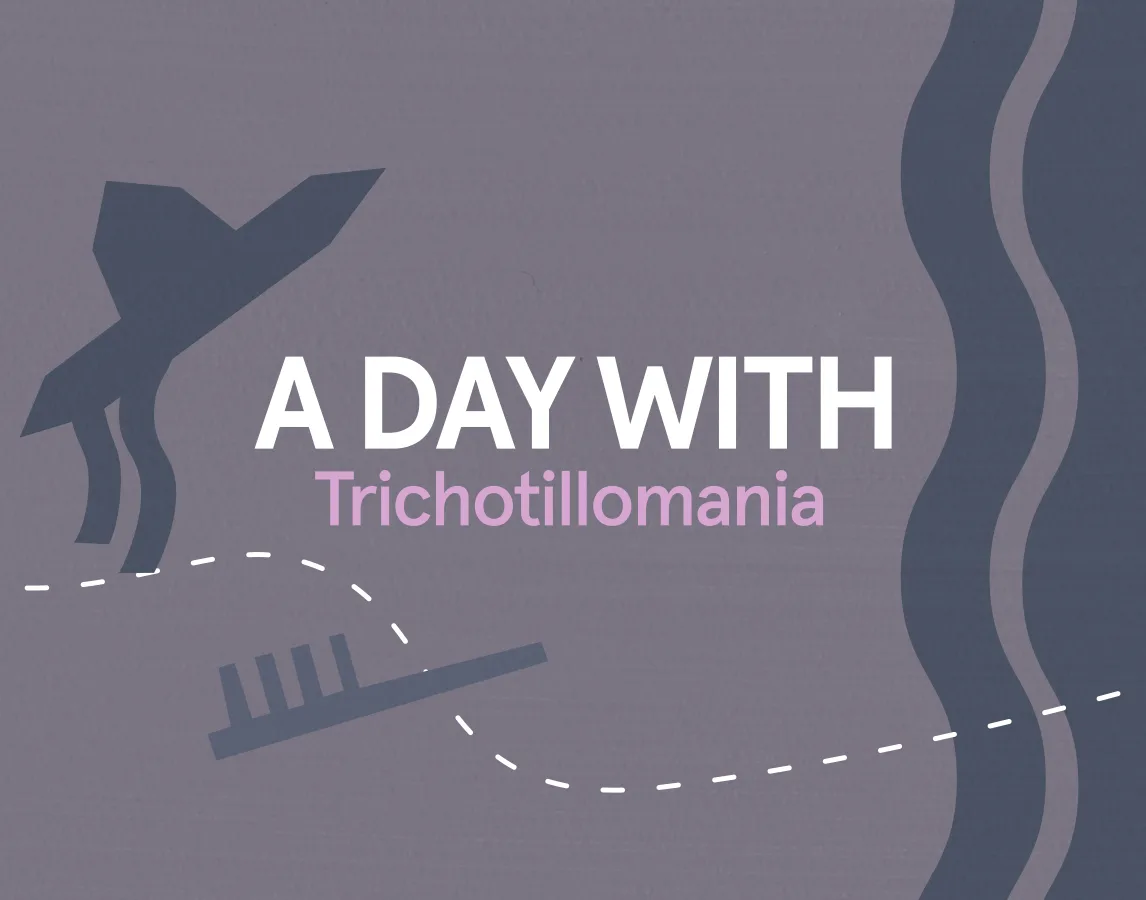A Day With: Trichotillomania
[Editor’s Note: This piece is part of an ongoing series of personal essays on what it’s like to live with a mental health diagnosis. Each piece describes a singular and unique experience. These essays are not meant to be representative of every diagnosis, but to give us a peek into one person's mind so we may be more empathetic to all.]
Growing up, I watched my mother spend almost an hour every day on her hair. She concocted a cocktail of serums and mousses to rub through her hair, then blew it dry, and wrapped chunks around the barrel of a curling iron to create pretty waves. She finished the process by spraying the strands into place. I remember wondering why she didn’t prefer sleeping in to the monotony of hair styling. Now, I wish I had the option.
Every morning I wake up and slip on a wig. I keep a collection of them in my bedroom; they range from chic blonde bobs to androgynous cropped styles that mirror Twiggy’s signature look. Today, I choose a brunette bob—a recent favorite. I replenish my stash of wigs often because I ruin them—I pull out the strands until the wigs look lopsided. Still, this is preferable to pulling out my own hair. Since age 14, I have suffered from an obsessive-compulsive condition called trichotillomania, which involves constant urges to pull out my hair. Sometimes I feel my scalp burning and ripping out a strand creates a sense of relief. Other times I pull hair subconsciously. I have tried using stress balls, wearing rubber gloves, cross-stitching, wearing hats—all to keep my hands away from my head. I’ve not been able to find successful treatment, despite expensive therapy bills. In short, I cannot stop. I imagine my last movement on earth will involve my pulling out a strand of hair. I accept my disorder, but I always feel unattractive, and I often dream about a life in which I have sexy, enviably thick locks.
Right now my best treatment for trichotillomania is wearing a wig. My scalp has massive bald spots from where I concentrate my pulling, and wigs hide these well. Although I also pull these strands from the wigs, I can switch to a new wig when necessary. I cannot switch out my own scalp. Wearing a wig saves time. This morning I spent 45 seconds shimmying it into place and brushing it. I then went into work and when I arrived at my desk, pulled out a lint roller—always my first activity of the work day. I remove any extra wig strands left on my chair from the previous day and settle into the day’s workload. I remember my father handing me the vacuum, saying, “clean it up.” He would find hair everywhere. As the day continues, I keep busy with both hands on the computer. (It helps to have a job that keeps both my hands occupied the majority of the time.) Meetings are difficult to navigate. After lunch, I meet with my superior. Because my anxiety rises in the presence of authority, I pull wig strands out throughout the meeting. I feel embarrassed; it makes me look unprofessional yet I cannot stop. My condition has sadly hindered my upward movement at work—my coworkers know about my condition and that I wear a wig, but the pulling continues to give the impression that I’m disengaged. Supervisors have offered this feedback during every job review, and although I know for certain that I am fully present, my body language suggests otherwise.
When the workday is complete, I return home and rip off my wig. Wearing it can feel heavy and cause my scalp to itch. Next I dress for exercise; I prefer to run alone outside as it spares me from the discomforts of wearing a hat at the gym. Running outdoors suits me because it keeps my hands out of my hair and I feel free to go bald. However, inclement weather means I head to the gym instead. I pull my baseball cap as close to my ears as possible to hide the bald spots. When I arrive in the locker room to cool down after a cardio session, I remove the cap and expose my head. An older woman standing next to me shoots me a sympathetic look. I get this look often—people assume I have cancer. I say nothing because explaining trichotillomania makes those sympathetic faces morph into confused ones. I shrug my shoulders, throw on my cap, and offer her a half smile. Once home, I shower before bed to keep my hair wet until I fall asleep, as wet hair makes the strands too difficult to pull out. I wish I could keep my hair wet all the time. Better yet, I wish I could set my alarm an hour earlier to style my hair, just like my mother. But I don’t. And I never will.



Be kind to your mind
- Access the full library of 500+ meditations on everything from stress, to resilience, to compassion
- Put your mind to bed with sleep sounds, music, and wind-down exercises
- Make mindfulness a part of your daily routine with tension-releasing workouts, relaxing yoga, Focus music playlists, and more
Meditation and mindfulness for any mind, any mood, any goal

Stay in the loop
Be the first to get updates on our latest content, special offers, and new features.
By signing up, you’re agreeing to receive marketing emails from Headspace. You can unsubscribe at any time. For more details, check out our Privacy Policy.
- © 2025 Headspace Inc.
- Terms & conditions
- Privacy policy
- Consumer Health Data
- Your privacy choices
- CA Privacy Notice
